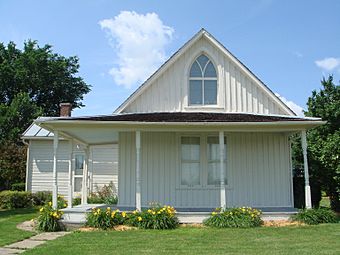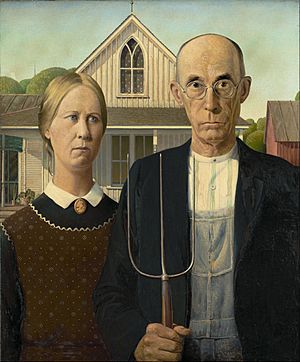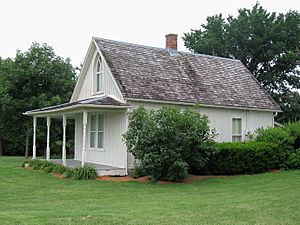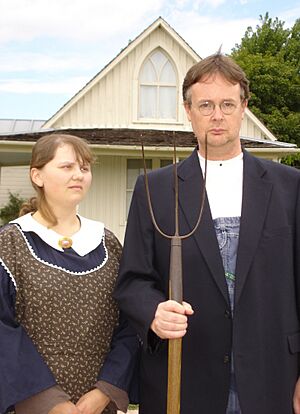American Gothic House facts for kids
Quick facts for kids |
|
|
Dibble House
|
|
 |
|
| Location | 300 American Gothic Street Eldon, Iowa |
|---|---|
| Area | 504 sq ft (46.8 m2) (house) .92 acres (0.37 ha) (lot) |
| Built | 1881–1882 |
| Architect | Bussy and Herald (local carpenters) |
| Architectural style | Carpenter Gothic |
| NRHP reference No. | 74002291 |
| Added to NRHP | October 1, 1974 |
The American Gothic House, also known as the Dibble House, is a famous house in Eldon, Iowa. It was built in a style called Carpenter Gothic, which means it looks a bit like a church with its pointed windows. This house became super famous because it was the background for the 1930 painting American Gothic by Grant Wood. This painting is one of the most well-known artworks in American history.
Grant Wood only saw the house twice. He made a quick sketch of it, but he finished the actual painting in his studio in Cedar Rapids. The house was built in 1881 and 1882 for Charles Dibble. It was a private home for many years. In 1991, the house was given to the State Historical Society of Iowa. Now, you can visit the house, which looks like it did in 1930, and there's also a visitors center. The house was added to the National Register of Historic Places in 1974. Since 1991, people have continued to live in the house as caretakers.
House History and Style
Charles A. Dibble was a Civil War veteran and lived in Eldon in the late 1800s. He and his wife, Catharine, started building their home in 1881. They had eight children. The house was quite simple, with white wooden siding and a small size of about 504 square feet. This style was common for homes in Iowa back then. For example, the birthplace of President Herbert Hoover in West Branch looks similar.
The American Gothic House has two special pointed windows on its upper level. These are called Gothic windows. No one knows for sure why the Dibbles chose these windows. People think they might have bought them from a Sears catalog. One idea is that they wanted to make their home look nicer during a time when life in rural Iowa was tough. Another idea is that fancy details were popular back then, and these windows were a reasonably priced way to add style.
Around 1897, the Dibbles lost their house because they couldn't pay their taxes. The house was then owned by several different families. In 1917, Gideon and Mary Hart Jones bought it. The Jones family owned the house until 1933. They added a kitchen, which created a new part of the house. It was the Jones family who allowed Grant Wood to use their home for his famous painting.
The American Gothic Painting

In the summer of 1930, an art director named Edward Rowan from Cedar Rapids came to Eldon. He wanted to bring art to the small town. He opened an art gallery and library and taught art classes. Grant Wood, who was from Anamosa, Iowa, came to Eldon because he felt he owed Rowan a favor.
In August, Wood was driven around Eldon by a local painter, John Sharp. Wood was looking for ideas for his art. Sharp's brother later said that Wood first sketched the house on the back of an envelope during this drive. Wood didn't think the house was beautiful at first. He thought it was a bit silly to put a Gothic window on such a simple house. But he found it very interesting and "very paintable."
The next day, Wood got permission from the Jones family. He made a sketch of the house from their front yard using oil paints on paperboard. In his sketch, he made the roof steeper and the window longer than they were in real life. These changes ended up in his final painting. However, Wood did not add the people to the sketch until he went back to Cedar Rapids. He never returned to Eldon, but he asked for a photo of the house to help him finish his painting.
Later Years and Today
Even after American Gothic became a famous American artwork, the house remained a private home. It was often rented out. In 1942, the Jones family sold the house to the Seldon Smith family. Grant Wood's sister, Nan Wood, who was the woman in the painting, started trying to save the house in 1945. In 1960, an architect named William J. Wagner visited the house, which was starting to look run down. He was one of the first people to suggest saving the house as a historic site.
In the early 1970s, the house was empty for a while. It was damaged by weather and even by people. By the late 1980s, the owner thought about giving the house to the state. Many people in southern Iowa had different ideas about what to do with it.
The house was placed on the National Register of Historic Places in 1974. After this, the owner fixed up the house. He added an indoor bathroom and electricity and repaired the windows. Local leaders hoped that fixing the house and adding a new museum would bring many visitors to Eldon.
In 1991, the house's owner finally gave the property to the State Historical Society of Iowa. There was an idea to move the house to Living History Farms near Des Moines. But the people of Eldon fought to keep it in their town. The house was renovated in 1992. People hoped it would become a popular tourist spot, like the Field of Dreams site in Dyersville.
Today, the American Gothic House Center welcomes about 15,000 visitors each year. Many more people visit after hours. Visitors can look at the house from the outside and take pictures. The visitors center even has aprons and jackets like those worn by the people in the painting, so visitors can dress up for their photos! The American Gothic House Center, built in 2007, has exhibits about the painting, Grant Wood, and the community. Every June, Eldon holds its Gothic Days festival. This event celebrates the painting and what rural life was like in Eldon in the 1930s. Since 2015, visitors can also take tours of the first floor of the house.
See also
 In Spanish: American Gothic House para niños
In Spanish: American Gothic House para niños



